How to Recover Shift Deleted Files on Windows 10 (2025)

However, if you hold down the shift key and press the delete button, the selected file will be completely removed from the computer (you won't find it in the recycle bin), as opposed to simply being "recycled" to a folder or directory called "Recycle Bin" when you delete files from a computer.
In this article you will find out:
- what is Shift + Delete combination
- how to recover shift deleted files
- how to protect your data
Are you ready? Let's read!
What Is Shift+Delete?
Shift+Delete is an advanced Windows OS function that completely erases a file or folder from a computer. Typically, when you delete a file on a Windows PC, the file is retained in the Recycle Bin for some days before the file gets permanently removed from the system.
The work of the recycle bin to hold back deleted files - just in case you had mistakenly deleted those files - so you can regain access to them by restoring them from the recycle bin.

But then, when you combine the SHIFT key with the DELETE key, the selected file for deletion won't be kept in the recycle bin; it'd be erased totally. So basically, holding down the SHIFT and DELETE keys tells the computer that the selected file should be removed entirely from the system and not retained in the recycle bin.
But then, notwithstanding, when you use the SHIFT+DELETE keys to erase a file, the file won't be found in the recycle bin, but it's still saved in a hidden directory on your HDD or SSD. Because shift-deleted files are not visible (not seen in the recycle bin), if you later change your mind about getting them back, you'd need to use a Recovery app.
Where Do Shift Deleted Files Go?
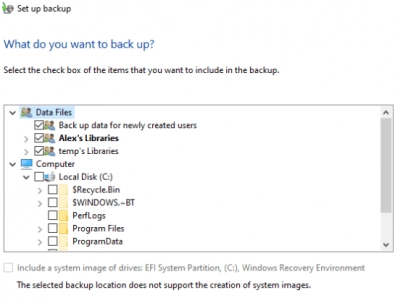
Shift-Deleted files are stored in a hidden directory on your primary storage disk; yes, they're not completely GONE, but hiding in a place you can't easily see without going through some processes.
Also, when you use SHIFT+DELETE to erase files from a PC and later decide to get back those files, it is important that you stop saving new files on that PC. Why? Continuously saving new files on the same PC would, over time, overwrite those deleted files, and you won't be able to get them back ever again!
Are Shift-Deleted Files Recoverable?
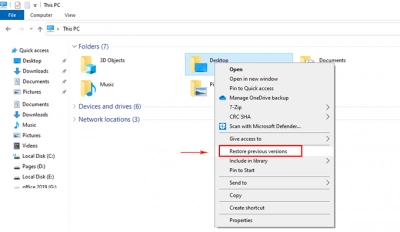
YES, they are. You can recover shift-deleted files following quite different techniques, one of which is using a data recovery software capable of searching deeper into hard drives to look out for hidden files.
If you don't want to use a third-party software for the recovery, you can use the built-in "Restore" utility on Windows OS systems; the utility is available on the Control Panel page. Hereunder are clear guides on recovering shift-deleted files following different methods and, of course, using different utilities.
Best Methods to Recover Shift Deleted Files
1. Using DiskInternals Uneraser Data Recovery Software

DiskInternals Uneraser is a professional utility software app developed for Windows OS users. It allows you to read and retrieve lost or deleted files from HDDs, SSDs, and other types of storage devices. This software tool supports all known Windows OS and Linux file system formats, including NTFS, APFS, FAT32/exFAT/FAT, and others.
DiskInternals Uneraser features an intuitive interface that anyone can easily understand and use. Yet, it also comes with a built-in Recovery Wizard that guides the users every step of the way. It scans deep into storage drives to retrieve every bit of data available in the selected drive.
How To Use DiskInternals Uneraser

Firstly, DiskInternals Uneraser from the official web page and install it on a working Windows PC. This software utility can run on any Windows OS system running version 7.0 up to the newest version 11.0.

Step One:

Connect the drive where the shift-deleted files were previously saved. If it's your primary disk, there is no need to connect any drive - proceed with launching the Uneraser software.
Step two:

The Recovery Wizard would launch automatically to guide you through the process; select the disk you want to recover from and select the file format you want to recover (you can mark all the file types available). On the next screen, choose between Quick Scan and Deep Scan; choose deep scan if you want a wholesome recovery.
Step three:
Allow DiskInternals Uneraser to scan the disk and discover all the files you have ever saved on it. At the end of the scan, you’d be presented with all the files you’ve ever saved on the drive, with the deleted/lost ones indicated with a RED asterisk.
Step four:
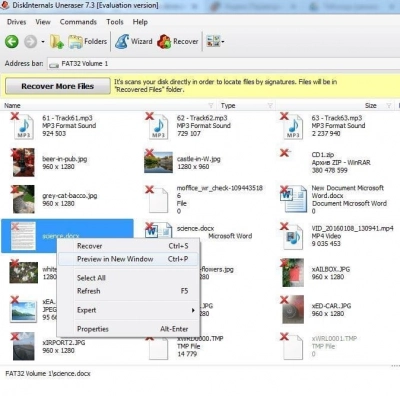
You can preview the recovered files, but to save them back to another storage, you must upgrade to the DiskInternals Uneraser Pro version.
Video guide on lost data recovery
2. How to Recover Shift Deleted Files from File History
Well, you may be skeptical about using 3rd-party software programs; hence, here's a method you may prefer. Windows OS is user-friendly and has many handy features for the "Bad days."
Windows OS has a built-in data backup and recovery tool called File History. As the name implies, this utility tool saves the "histories" (previous versions) of every file you save on your PC. So, in a case of data loss, you can refer to the File History tool and retrieve a previous version of the lost/corrupted file.
Where to find this utility tool? It’s accessible from the Control Panel options - under the Security section.
Steps:
- Click on the Search button and launch the Search bar. Search for file History, and click on the corresponding app/settings link that'd appear in the search results.
- If you haven’t previously turned on File History, you’d be requested to turn it on. File history must be turned on initially before you can use it as a data recovery solution in the case of data loss.
- In contrast, if you had activated File History prior to the data loss, simply click on Restore My Files and vie the previous histories of your files.
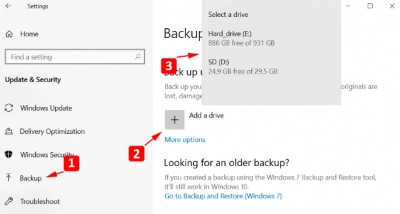
To setup file history, follow the steps below:
- Open the Settings page and go to Update & Security > Backup.
- Click on the “Add a Drive” button and choose a drive (Network drive or external drive).

- Turn on "Automatically back up my files" to allow Windows to back up your files hourly.
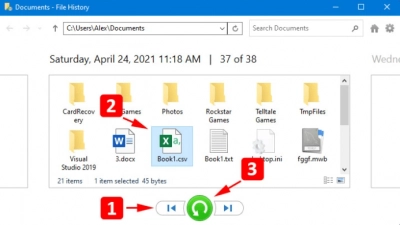
What To Know: This method is not a failsafe, and you must have to enable File History before the deletion of the file. However, it eliminates the need for installing a third-party app for data recovery.
3. Using Live CDs or USB Drives
A Linux Live CD allows you to boot a computer without bothering about storage drives; it also will enable you to access corrupted drives and attempt data recovery. There are pretty many Live CD solutions you can choose from.
Conclusion
This article explains the step-by-step guide for recovering shift-deleted files. The most reliable recovery method is using a professional data recovery tool like the DiskInternals Uneraser. Other methods discussed here can actually recover deleted files, but they are not so efficient.
Finally, once you use the SHIFT+DELETE keys to erase files from your PC, minimize the number of new files you save to avoid overriding the files. Whichever way you deleted a file from a computer, Uneraser can help get back the files.
FAQ
- What is Shift + Delete shortcut?
Shift + Delete: What does that mean? When a file is chosen in Windows and the Shift and Delete keys are simultaneously pressed, the file is permanently deleted without first being moved to the Recycle bin. Use caution while using this shortcut since it might save you time but also get you into a lot of trouble.
- How can I recover Shift-deleted files in Windows 10?
1. Select Search by doing a right-click on the Start.
2. Search for Control Panel.
3. Select Backup and Restore under System Security.
4. In the lower right corner, click the Restore my files button.
5. To check which files can be restored to their prior state, choose Browse for folders.
- What is Shift + Delete in Excel?
Shift + Delete: Using this shortcut, you may delete a row, column, or set of cells while also moving the other cells to the right or left. The chosen cells, column, or row will be deleted when you press Ctrl + Shift + Delete, and the remaining cells will be moved to the right or down.
- How to recover shift deleted files without recovery software?
Free File History Backup in Windows 10 for Restoring Permanently Deleted Files:
1. Click the Start button.
2. Hit Enter after typing "restore files" on the keyboard.
3. Search for the folder containing the deleted files.
4. To restore deleted Windows 10 files to their original location, use the "Restore" button in the center.
- How to recover shift deleted files using command prompt?
1. Windows + R in a search box, type CMD.
2. Type chkdsk 'drive letter' /f and press Enter (For e.g.: C : \ USERS\ PROGRAM FILES\ chkdsk D : /f)
3. Press Y 'Yes' until the command lines start again.
- Where do shift deleted files go?
The file is not placed in the Recycle Bin when you remove it by pressing Shift + Delete. Windows, as opposed to the file itself, just modifies the file table, a comprehensive list of source files with all of their many properties, to indicate that the storage region occupied by the file is open for usage.

